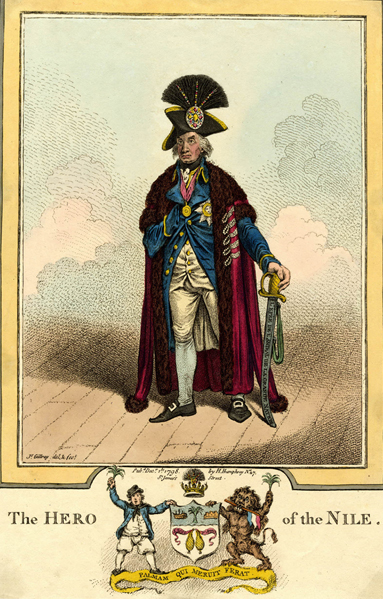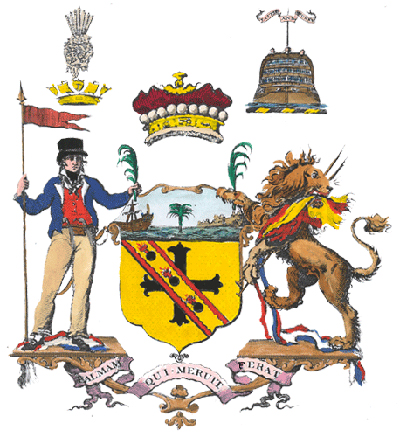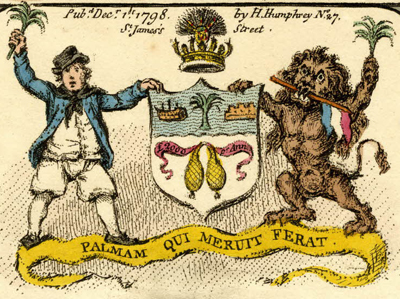The Hero of the Nile
Even before the Battle of the Nile, Nelson had captured the imagination of the British public with his daring seamanship, his utter disregard of his personal safety (he lost an eye and an arm in battles), and his successes at the Battle of Cape St. Vincent and the Battle of Santa Cruz de Tenerife. After the Battle of the Nile, where his unexpected late afternoon attack caught the French totally off guard and led to the capture or destruction of most of the French fleet, he was arguably the most famous man in England.
Gillray's "serious" portrait of him in The Hero of the Nile was the culmination for Gillray of a flurry of prints celebrating Nelson's triumph. And it is probably the best non-caricatured portrait of Gillray's career. It shows Nelson at full length standing upon an unadorned, ship-like, wooden deck bearing the fruits of his labors: a peer's robe, the captured sword of the French commander, the badge and medal of the Order of the Bath, and the fabulous gem-laden chelengk atop his naval hat presented to Nelson by the Sultan of Turkey, Selim III, in gratitude for driving the French out of his territory.

© Trustees of the British Museum
Although like most portraits of Nelson, Gillray's version probably owes something to the paintings of Lemuel Francis Abbott, Gillray has made numerous changes, from increasing the size of the chelengk and adding the sword and peer's robe, to altering Nelson's expression making it less idealized and more convincing. The result is an image that is heroic but credible.

Horatio Nelson
[1798]
© National Maritime Museum
But though the portrait of Nelson is as fittingly serious as the image of a British naval hero should be, Gillray seems to have been unable to resist poking fun at the modifications allowed to the Nelson family crest after the Nile victory. Here is the actual revised crest.

© Trustees of the British Museum
And here is Gillray's version.

© Trustees of the British Museum
The Latin motto, present in both versions, has its origins in Greece, specifically Sparta, where a palm branch was awarded for oustanding achievement rather than a laurel wreath. The motto can then can be translated as "He who deserves the palm [i.e. the reward] should bear [possess] it. But Gillray caricatures the staid heraldic "supporters" (the sailor and lion), and alters the original family crest to include the reward that would have probably meant the most to the average Briton—two bags of money representing Nelson's pension of £2000 per annum.
Sources and Reading
- Commentary from the British Museum on The Hero of the Nile.
- "Horatio Nelson, 1st Viscount Nelson," Wikipedia
- "Battle of the Nile," Wikipedia
- "Order of the Bath," Wikipedia
- "Nelson's Chelenqk," The Telegraph
- Thomas Wright and R.H. Evans, Historical and Descriptive Account of the Caricatures of James Gillray #211
- Thomas Wright and Joseph Grego, The Works of James Gillray, the Caricaturist; With the History of His Life and Times p. 249.
Comments & Corrections
NOTE: Comments and/or corrections are always appreciated. To make that easier, I have included a form below that you can use. I promise never to share any of the info provided without your express permission.